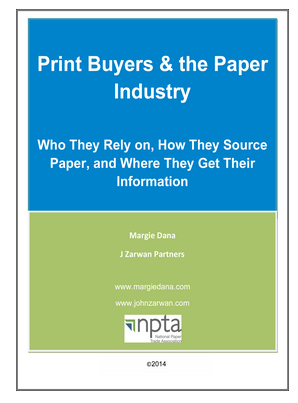 |
||||||||
| January 14, 2015 | ||||||||
| Report says print buyers want more attention from the paper industry |  |
|||||||
|
· Subscribe to Ahead of the Curve · Newsletters · Ahead of the Curve archived issues · Contact the Editor
 |
A pulp and paper rebirth (Editor's note: The following article appeared in the Atlanta Journal-Constitution on December 31, 2014.) By Larry Montague  After years of downsizing, the pulp, paper and packaging business—one of Georgia’s largest industries—is quietly being revitalized. While the Internet and other electronic devices have led to reduced paper use, several Atlanta companies and researchers are developing new uses for paper and wood-based products. Their efforts likely will have a significant impact on local businesses and give new vitality to an industry that has been a mainstay to the Georgia economy for decades. The pulp, paper and packaging business in Georgia is valued at $11 billion and employs nearly 19,000 people. Two major corporations that produce these materials—Georgia-Pacific and RockTenn—are headquartered in this state. The revitalization is led by companies and researchers developing new materials from trees to partially replace plastics and metal. These new, wood-based materials are lighter and stronger than some metals, which appeals to manufacturers. And because they are made from wood, they are sustainable and can be recycled—the ultimate win-win scenario. One of the best examples of these entrepreneurial companies is American Process, a privately held firm based in Midtown [Atlanta]. It developed a proprietary manufacturing process to make nanocellulose, a renewable material derived from wood fiber, and plans to begin operating a commercial pilot nanocellulose plant in Thomaston, by April. Working with several research universities, American Process is developing ultra-strong, lightweight components for automobiles reinforced with nanocellulose. The goal is to replace heavy steel structures, such as seat frames, with nanocellulose composites, which are lighter and cost less than the carbon fibers used now. Researchers at Georgia Tech’s Renewable Bioproducts Institute are also on the cutting edge of these changes. Robert Moon, a Tech adjunct professor, is working to increase the strength of cement while reducing the cost to produce it by adding nanocellulose crystals. Moon’s role is to accelerate research and development of nanocellulose at Tech and throughout the region. Kyriaki Kalaitzidou, another Tech researcher, is also exploring the use of nanocellulose to reduce vehicle weights. She recently received funding to find out if these materials can make Yahama’s new nano-produced golf carts and Wave-Runners lighter and stronger. Heavily involved in these changes is TAPPI, the leading technical association for the pulp, paper, tissue, packaging and converting industries headquartered in [Atlanta's] Peachtree Corner’s Technology Park. It has more than 7,500 members in 66 countries and has been driving education, professional development and technological advancements in the industry for almost a century. TAPPI is also changing with the times. With the establishment of a new international Nanotechnology Division, TAPPI has begun creating nanocellulose standards and is working with some of the leading experts in this field to shape innovation and set the stage for commercial application and consumer use of these sustainable, green products. As nanocellulose technology continues to advance, TAPPI is working with some of the largest manufacturers and suppliers to educate the public on “rethinking trees” and how this industry will impact the economy, create new employment opportunities and generate growth for Georgia. With new companies and research in metro Atlanta at the forefront of paper technology, TAPPI is well-positioned to take advantage of its technical expertise and apply it to the local economy. Larry Montague is president and CEO of TAPPI. Now that you are Ahead of the Curve, stay there by joining TAPPI. |
|||||||
 |
||||||||